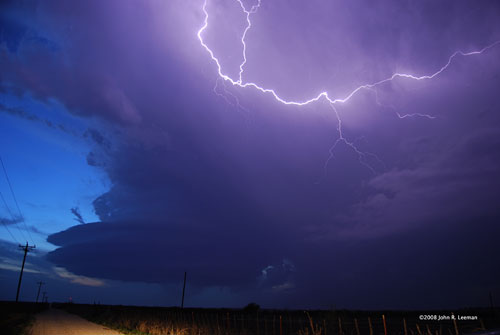
Tornado hunters may have a new, unlikely ally - electricity. Armed with only an antenna mounted on top of a vehicle and a simple receiver, researchers can pick up low-frequency electromagnetic waves - a possible sign that a tornado is brewing. The frequency of the signal should even tell them the ferocity of the storm.
The researchers were interested in a type of rotating storm known as a "supercell", which is characterised by heavy wind, rain, and hail, along with a vortex of swirling air several kilometres wide. About 30% of supercells spawn tornados as this vortex descends towards the ground.
Ernst Schmitter from the University of Applied Sciences Osnabrueck in Germany and his colleague, John Leeman from the Leeman Webb Storm Laboratory think that it is this swirling action that generates the electromagnetic radiation in the tornado.
When the dust particles and droplets rub against each other, they become oppositely charged. The lighter particles, which are mostly negative, get blown to the top of the funnel while the heavier positive ones sink to the bottom.
As the separated particles rotate around the vortex, they act as a source of low frequency electromagnetic radiation. This can easily be picked up by a receiver and transformed into an oscillating wave on a monitor. Non-rotating storms produce nothing more than electrical noise.
Night sight
At present, most tornado detection relies on groups of roving "tornado spotters" or is done using weather radar. This involves sending out a stream of microwaves to bounce off the rain droplets or hail particles in the storm. Some of the energy gets reflected back towards a receiver from which an image of the inside of the storm is created and any potential tornados can be spotted. The distance to the tornado can also be calculated.
Schmitter reckons that detecting the electromagnetic waves should offer advantages over both methods. Low-frequency radiation can penetrate further through cloud than microwaves, giving a more accurate picture of the heart of storm. The new approach should also be quicker as an electromagnetic signal could be picked up instantly whereas it takes a few minutes to refresh each new radar scan.
The method would also offer advantages over tornado hunters who rely on eyes alone to gauge developing storms and cannot always get close enough to the storm to get a clear picture of the area of rotation.
Collecting signatures
"It would be useful to have another independent way of establishing if a tornado is present in cases of poor visibility such as at night, in heavily wooded areas, or when there is wide-spread rain obscuring visibility," says Melville Nicholls of the University of Colorado at Boulder.
So far the team have only managed to capture the electromagnetic wave from one fairly weak tornado. They plan to continue collecting data to build up a larger database of tornado "signatures". "We are also investigating if we can determine when the tornado will touch down by looking at the strength of the electromagnetic field," says Leeman.
"Many more tornado warnings are issued per year than tornadoes occur," says Paul Knightley of the weather forecasting company MeteoGroup UK, "so any new methods of detection would certainly cause interest."
He adds that more observations are needed before we get too excited about electro-detection.
Journal reference: Atmospheric Research (DOI: link)



Reader Comments
to our Newsletter